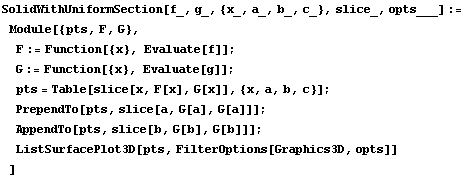
Solids with Uniform Cross Sections
I used the following notebook to demonstrate finding the volume of solids with uniform cross sections. After executing the first command in this notebook, you will be asked "Do you want to automatically evaluate all the initialization cells in the notebook?" Click Yes, and Mathematica will automatically execute the commands under "Initialization Code."
The most complicated part of these graphics is dealing with the many options involved: What are we rotating around? Do I want to look at the solid from the top, the bottom, the side, or somewhere else? This picture is too tall (or short)--how can I make it a more manageable size? To keep things from being too intimidating for my students, I set a bunch of defaults for the particular example I was doing in the initialization section.
First, I made a picture of the solid whose base is bounded by  , the x-axis, and
, the x-axis, and  , and whose cross-sections perpendicular to the x-axis are squares. The code for SolidWithUniformSection is in the initialization section. The arguments are the top curve, the bottom curve, the domain specification (including the step size), and the kind of slice (SquareSlice, EquilateralTriangleSlice, or SemicircleSlice).
, and whose cross-sections perpendicular to the x-axis are squares. The code for SolidWithUniformSection is in the initialization section. The arguments are the top curve, the bottom curve, the domain specification (including the step size), and the kind of slice (SquareSlice, EquilateralTriangleSlice, or SemicircleSlice).

Here are two different views of the solid. The first is looking perpendicular to the x-y plane, highlighting the  relationship. The second is looking along the x-axis, highlighting the nature of the square cross-sections.
relationship. The second is looking along the x-axis, highlighting the nature of the square cross-sections.

The following pictures focus on a single slice within the solid, in particular a slice from  to
to  . I used the same three viewpoints as before.
. I used the same three viewpoints as before.


As a second example, consider the solid whose base is bounded by  ,
,  , and
, and  , whose cross sections perpendicular to the x-axis are equilateral triangles.
, whose cross sections perpendicular to the x-axis are equilateral triangles.

Initialization Code



These are the slice functions. If you wish to make your own, it should take three arguments: the x-coordinate, the y-coordinate of the top curve, and the y-coordinate of the bottom curve. The function should return a list of three-dimensional points that are the vertices of the polygon at that slice.


